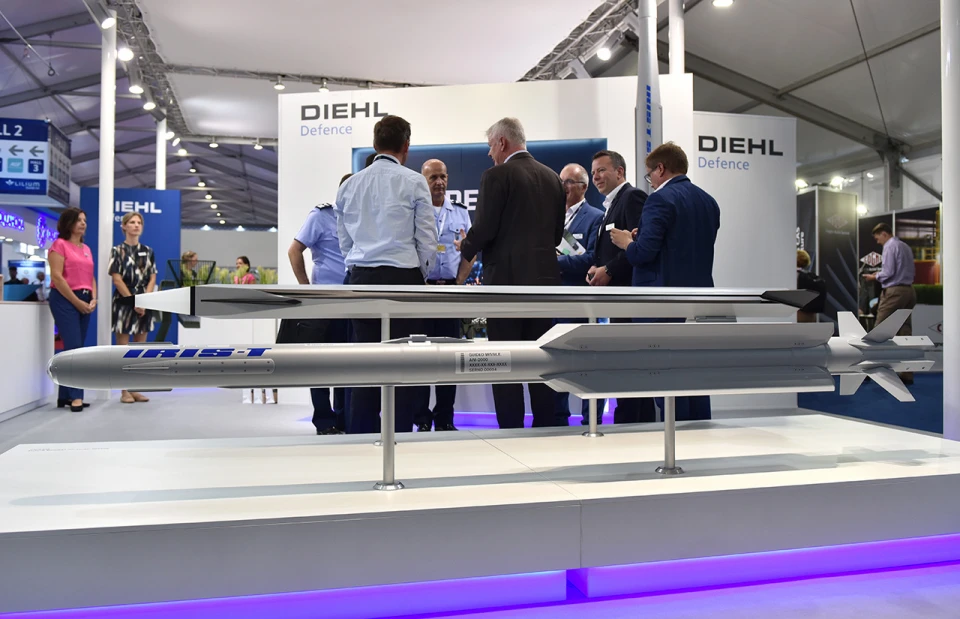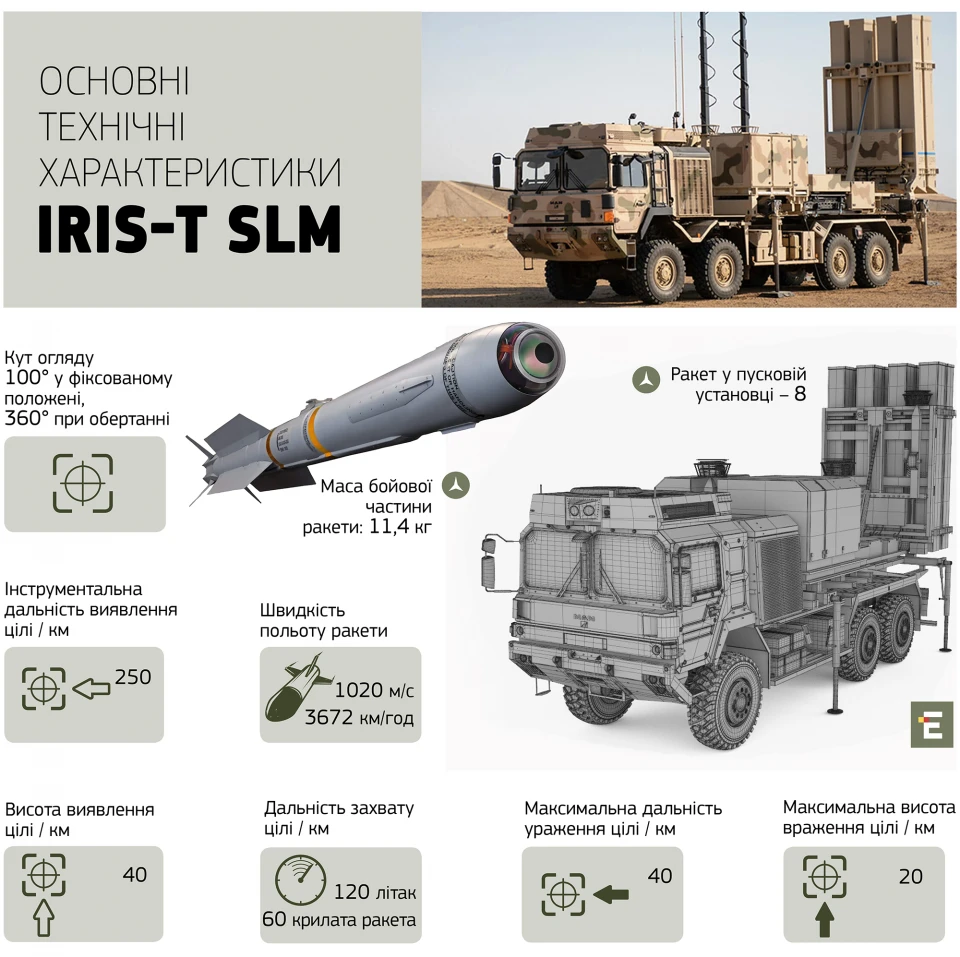
What is IRIS-T SLM and how German complexes improve air defense of Ukraine
Espreso on the German anti-aircraft missile complex, which Ukrainian soldiers successfully use in air defense, its technical characteristics, cost and features
What is the IRIS-T missile?
The IRIS-T rocket is an air-to-air missile made through collaboration among European countries. It has a special infrared homing warhead that can track and hit targets. The project started in 1996 and involved countries like Germany, Greece, Italy, Norway, Sweden, Spain, and Canada (although Canada later left the project). The main manufacturer is a German military company called Diehl. They finished testing the air version of IRIS-T in 2002, and in 2003, Germany and other countries began buying these missiles for their air forces. The IRIS-T missiles can be used on different fighter jets like Eurofighter, F-16, EF-18, Tornado, and Saab Gripen. They are effective against airplanes, helicopters, and other missiles.
The missile consists of five modules: electronic equipment, a cooling system, a guidance system, a warhead and an engine with controls and a detonator.
The cost of the IRIS-T air-launched missile is approximately 350,000 euros. An approximate analogue - the American AIM-9X missile costs about 600,000 dollars.

How was it created?
The creation of the IRIS-T SLM air defense complex involved upgrading the missile for ground-based launches. The main focus of the air defense system's development was to increase the range as it needed to be launched from the ground.
Diehl, the manufacturing company, developed three different launch systems:
- IRIS-T SLS: a short-range air defense system with a range of up to 12 km.
- IRIS-T SLM: a medium-range air defense system with a range of up to 40 km.
- IRIS-T SLX: a long-range air defense complex that has been in development since 2021.
The SLS and SLM systems were introduced in 2014. Sweden was the first country to receive these installations in 2019, followed by Norway. Ukraine received the medium-range complex. Although formally adopted by Germany in 2017, the Bundeswehr has not yet received actual deliveries.
Manufacturers are currently working on modifying the long-range air defense system. In the same year, Diehl showcased this system at various international exhibitions.
What is the IRIS-T SLM and how does it work?
The IRIS-T SLM is a modern air defense system developed by Germany. Its main purpose is to destroy airplanes, helicopters, unmanned aerial vehicles, cruise missiles, and ballistic missiles.
The system consists of three main parts: a launcher mounted on a MAN SX 45 truck chassis (8x8) that can hold eight missiles, a radar system, and a control machine. The launchers can be transported on tracked platforms or trucks, not necessarily the ones provided by the manufacturer. The system can receive data from the included radars as well as from other radar systems.
The IRIS-T SLM complex features an upgraded version of the IRIS-T anti-aircraft guided missiles. These missiles can engage targets up to 40 kilometers away and at altitudes of up to 20 kilometers. They have improved maneuverability due to a solid-fuel engine with controlled thrust.
The missiles utilize an infrared homing head that is well protected against countermeasures. In simple terms, they use heat to guide themselves towards their target. However, the smart guidance system of the missile can remember images and compare them with stored data, allowing it to distinguish between real targets and decoys. The missile itself remains undetectable until it hits the target since it does not emit any signals.
One significant advantage of the system is its capability to engage multiple targets simultaneously. With all three launchers fully loaded, the complex can launch 24 missiles, meaning it can potentially engage 24 targets at once. The air defense system can cover an area of 196,000 square kilometers or a strip of land that is 175 kilometers long.

Technical specifications of IRIS-T SLM
- Number of missiles in the launcher: 8
- Range for detecting targets using instruments: 250 km
- Height at which targets can be detected: 40 km
- Range for capturing targets: 120 km (for aircraft), 60 km (for cruise missiles)
- Viewing angle: 100° in a fixed position (360° when rotating)
- Maximum range for damaging targets: 40 km
- Maximum target altitude: 20 km
- Rocket flight speed: 1020 m/s or 3672 km/h
- Warhead weight: 11.4 kg
Cost of IRIS-T SLM
It is difficult to determine the exact cost of the system. Western media previously reported a contract for Ukraine's purchase of 11 batteries for an estimated 1.5-2 billion euros (around 140-178 million euros per battery). For instance, last summer Welt mentioned the price of 140 million euros for each of the 11 IRIS-T SLM installations. However, it is unclear what exactly is included in this cost. The official configuration of the IRIS, such as the number of launchers and radars in one battery, is also not disclosed.
The cost of the IRIS-T SL surface-to-air missile alone is unknown, as it was never delivered separately from the systems. The base version is estimated to be priced between 320,000 and 380,000 euros. Experts believe that the "adapted version" would likely be more expensive.
What can the IRIS-T SLM do?
The chief specialist of the anti-aircraft missile training department of the Ukrainian Armed Forces, Denys Smazhnyi, explained that the IRIS-T radar is designed to help counter missiles like the Kh-22 or Kh-101, which fly at low altitudes and use stealth technology that makes them hard to detect for older air defense equipment and radars.
However, Denys Smazhnyi emphasized that the IRIS-T alone is not sufficient to protect Ukrainian skies, particularly against threats like ballistic missiles. The IRIS-T guided missile weighs only 130 kg, while missiles such as Iskander or Kinzhal have warheads weighing 500 kg. “It's like driving a car through a swarm of insects; the driver wouldn't even notice it,” Smazhnyi noted.
While the IRIS-T SLM can effectively engage against Kalibrs or supersonic cruise missiles, it is unlikely to be effective against ballistic missiles. Intercepting ballistic targets is challenging because these missiles fly almost vertically at extremely high speeds, reaching up to 2700 km/h. The IRIS-T SLM's range of 20 km would be covered by the missile in just 26 seconds. In comparison, the Kalibr cruise missile would be vulnerable for 2.7 minutes, six times longer. But the primary focus of the IRIS-T SLM is to engage aircraft and cruise missiles, not ballistic missiles.
Denys Smazhnyi suggests that an effective multi-layered anti-missile defense system, which includes IRIS-T, NASAMS, and Patriot, would be necessary to effectively counter ballistic missile threats.
IRIS-T SLM in Ukraine
Germany announced on June 1, 2022, that they would provide Ukraine with modern air defense systems. One of these systems is the IRIS-T SLM anti-aircraft system.
The first complex was delivered to Ukraine on October 12, and Chancellor Scholz pledged to send three more, each capable of protecting a large city.
During its first use, the IRIS-T system successfully destroyed all of its targets.
Currently, two IRIS-T SLM systems are operational in Ukraine. The second one arrived in April this year, with Germany and Sweden cooperating on its delivery. Ukraine is expecting six more complexes, with two scheduled to arrive by the end of 2023 and four more in 2024.
About author: Roman Yavorskyi, journalist
- News











































